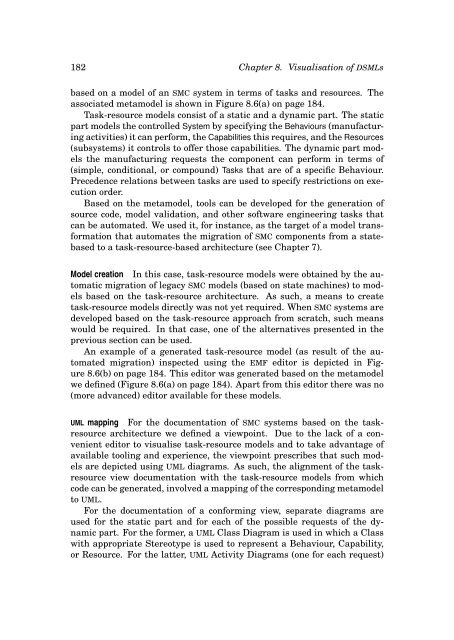Model-Driven Evolution of Software Architectures - Software and ...
Model-Driven Evolution of Software Architectures - Software and ...
Model-Driven Evolution of Software Architectures - Software and ...
You also want an ePaper? Increase the reach of your titles
YUMPU automatically turns print PDFs into web optimized ePapers that Google loves.
182 Chapter8. Visualisation<strong>of</strong>DSMLs<br />
basedonamodel<strong>of</strong>anSMCsysteminterms<strong>of</strong>tasks<strong>and</strong>resources. The<br />
associatedmetamodelisshowninFigure8.6(a)onpage184.<br />
Task-resourcemodelsconsist<strong>of</strong>astatic<strong>and</strong>adynamicpart.Thestatic<br />
partmodelsthecontrolled Systembyspecifyingthe Behaviours(manufacturingactivities)itcanperform,the<br />
Capabilitiesthisrequires,<strong>and</strong>the Resources<br />
(subsystems)itcontrolsto<strong>of</strong>ferthosecapabilities.Thedynamicpartmodelsthemanufacturingrequeststhecomponentcanperforminterms<strong>of</strong><br />
(simple,conditional,orcompound) Tasksthatare<strong>of</strong>aspecificBehaviour.<br />
Precedencerelationsbetweentasksareusedtospecifyrestrictionsonexecutionorder.<br />
Basedonthemetamodel,toolscanbedevelopedforthegeneration<strong>of</strong><br />
sourcecode,modelvalidation,<strong>and</strong>others<strong>of</strong>twareengineeringtasksthat<br />
canbeautomated.Weusedit,forinstance,asthetarget<strong>of</strong>amodeltransformationthatautomatesthemigration<strong>of</strong>SMCcomponentsfromastatebasedtoatask-resource-basedarchitecture(seeChapter7).<br />
<strong>Model</strong>creation Inthiscase,task-resourcemodelswereobtainedbytheautomaticmigration<strong>of</strong>legacySMCmodels(basedonstatemachines)tomodelsbasedonthetask-resourcearchitecture.<br />
Assuch,ameanstocreate<br />
task-resourcemodelsdirectlywasnotyetrequired.WhenSMCsystemsare<br />
developedbasedonthetask-resourceapproachfromscratch,suchmeans<br />
wouldberequired. Inthatcase,one<strong>of</strong>thealternativespresentedinthe<br />
previoussectioncanbeused.<br />
Anexample<strong>of</strong>ageneratedtask-resourcemodel(asresult<strong>of</strong>theautomated<br />
migration) inspected using the EMF editor is depicted in Figure8.6(b)onpage184.Thiseditorwasgeneratedbasedonthemetamodel<br />
wedefined(Figure8.6(a)onpage184).Apartfromthiseditortherewasno<br />
(moreadvanced)editoravailableforthesemodels.<br />
UMLmapping Forthedocumentation<strong>of</strong> SMCsystemsbasedonthetaskresourcearchitecturewedefinedaviewpoint.Duetothelack<strong>of</strong>aconvenienteditortovisualisetask-resourcemodels<strong>and</strong>totakeadvantage<strong>of</strong>availabletooling<strong>and</strong>experience,theviewpointprescribesthatsuchmodelsaredepictedusingUMLdiagrams.Assuch,thealignment<strong>of</strong>thetaskresourceviewdocumentationwiththetask-resourcemodelsfromwhich<br />
codecanbegenerated,involvedamapping<strong>of</strong>thecorrespondingmetamodel<br />
toUML.<br />
Forthedocumentation<strong>of</strong>aconformingview, separatediagramsare<br />
usedforthestaticpart<strong>and</strong>foreach<strong>of</strong>thepossiblerequests<strong>of</strong>thedynamicpart.Fortheformer,aUMLClassDiagramisusedinwhichaClass<br />
withappropriateStereotypeisusedtorepresentaBehaviour,Capability,<br />
orResource. Forthelatter,UMLActivityDiagrams(oneforeachrequest)

















